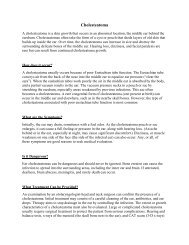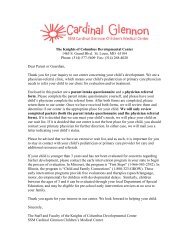Perforated Eardrum
Perforated Eardrum
Perforated Eardrum
Create successful ePaper yourself
Turn your PDF publications into a flip-book with our unique Google optimized e-Paper software.
How is a perforated eardrum treated?Before attempting any correction of the perforation, a hearing test should be performed. The benefits of closinga perforation include prevention of water entering the ear while showering, bathing, or swimming (which couldcause ear infection), improved hearing, and diminished tinnitus. It also may prevent the development ofcholesteatoma (skin cyst in the middle ear), which can cause chronic infection and destruction of ear structures.If the perforation is very small, an otolaryngologist may choose to observe the perforation over time to see if itwill close spontaneously. He or she might try to patch a patient’s eardrum in the office. Working with amicroscope, your doctor may touch the edges of the eardrum with a chemical to stimulate growth and then placea thin paper patch on the eardrum. Usually with closure of the tympanic membrane, hearing is improved.Several applications of a patch (up to three or four) may be required before the perforation closes completely. Ifyour physician feels that a paper patch will not provide prompt or adequate closure of the hole in the eardrum,or if paper patching does not help, surgery may be required.There are a variety of surgical techniques, but most involve grafting skin tissue across the perforation to allowhealing. The name of this procedure is called tympanoplasty. Surgery is typically quite successful in repairingthe perforation, restoring or improving hearing, and is often done on an outpatient basis.Your doctor will advise you regarding the proper management of a perforated eardrum.
















